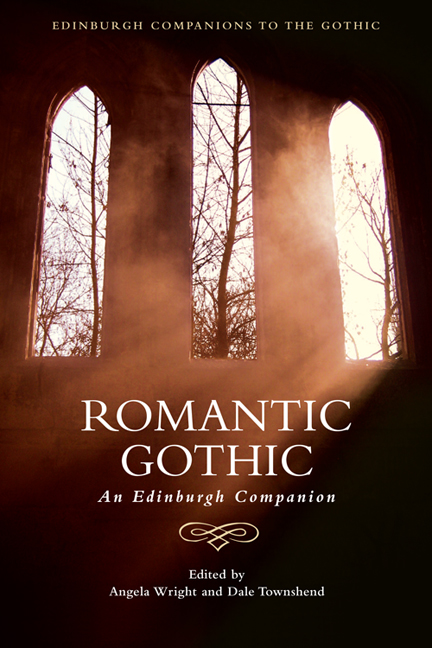Book contents
- Frontmatter
- Contents
- 1 Gothic and Romantic: An Historical Overview
- Part I Gothic Modes and Forms
- 2 Graveyard Writing and the Rise of the Gothic
- 3 Gothic Romance
- 4 The Gothic Stage: Visions of Instability, Performances of Anxiety
- 5 Gothic Poetry and First-Generation Romanticism
- 6 Gothic and Second-Generation Romanticism: Lord Byron, P. B. Shelley, John Polidori and Mary Shelley
- 7 Political Gothic Fiction
- 8 Shorter Gothic Fictions: Ballads and Chapbooks, Tales and Fragments
- 9 Oriental Gothic
- 10 Gothic Parody
- Part II National and International Borders
- Part III Reading the Romantic Gothic
- Notes on Contributors
- Index
4 - The Gothic Stage: Visions of Instability, Performances of Anxiety
from Part I - Gothic Modes and Forms
Published online by Cambridge University Press: 05 August 2016
- Frontmatter
- Contents
- 1 Gothic and Romantic: An Historical Overview
- Part I Gothic Modes and Forms
- 2 Graveyard Writing and the Rise of the Gothic
- 3 Gothic Romance
- 4 The Gothic Stage: Visions of Instability, Performances of Anxiety
- 5 Gothic Poetry and First-Generation Romanticism
- 6 Gothic and Second-Generation Romanticism: Lord Byron, P. B. Shelley, John Polidori and Mary Shelley
- 7 Political Gothic Fiction
- 8 Shorter Gothic Fictions: Ballads and Chapbooks, Tales and Fragments
- 9 Oriental Gothic
- 10 Gothic Parody
- Part II National and International Borders
- Part III Reading the Romantic Gothic
- Notes on Contributors
- Index
Summary
A relatively uncomplicated definition of ‘Gothic drama’ would describe it as the counterpart of Gothic romance, one in which the plots, themes and other appurtenances of the latter are transferred to the stage or, at least, into a dramatic text. Romantic-period commentators themselves recognised that drama appropriated the features made popular by contemporary Gothic fiction, translating them into a visual, multimedia and three-dimensional artefact. In his scathing attack on Charles Robert Maturin's Bertram (1816), Samuel Taylor Coleridge associated stage Gothic with hackneyed elements, including ‘ruined castles’, ‘dungeons’, ‘trap-doors’, ‘skeletons’, and ‘flesh-and-blood ghosts’ (Coleridge 1983: II:211). As the last item in this list suggests, stage versions of Gothic gave visual and material immediacy to the imaginings of fictional texts. Accordingly, in his foundational study of 1947, Bertrand Evans defined Gothic drama as being distinguished by ‘specialized settings, machinery, character types, themes, plots, and techniques selected and combined to serve a primary purpose of exploiting mystery, gloom, and terror’ (Evans 1947: 5).
Several plays performed and/or published between the 1760s and the 1820s conform to these features, and serve to delineate a potential canon of Gothic drama. The conventional starting point is Horace Walpole's The Mysterious Mother (1768, 1781, 1791), though with John Home's Douglas (1756) and Hall Hartson's The Countess of Salisbury (1765) as forerunners. In the 1770s and 1780s Gothic features evidently emerged in Robert Jephson's adaptation of Walpole's The Castle of Otranto (1764) as The Count of Narbonne (Covent Garden, 17 November 1781), but also in historical plays such as Hannah More's Percy (Covent Garden, 10 December 1777); Hannah Cowley's Albina (Haymarket, 31 July 1779); and Andrew Macdonald's Vimonda (Haymarket, 5 September 1787); plays inspired by classical antiquity such as Arthur Murphy's The Grecian Daughter (Drury Lane, 26 February 1772); operatic comedies like John O'Keeffe's The Castle of Andalusia (Covent Garden, 2 November 1782) and James Cobb's The Haunted Tower (Drury Lane, 24 November 1789); or pantomimes such as Miles Peter Andrews's The Enchanted Castle (Covent Garden, 26 December 1786).
- Type
- Chapter
- Information
- Romantic GothicAn Edinburgh Companion, pp. 73 - 94Publisher: Edinburgh University PressPrint publication year: 2015



